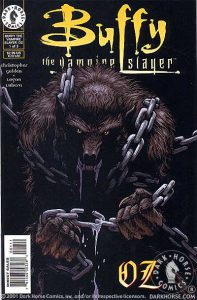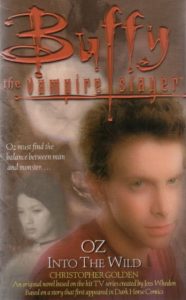Oz served an important role on “Buffy” as a representative of a classic monster (the werewolf), Willow’s boyfriend, and a steadying presence among the Scooby Gang. But, despite the fact that Seth Green was the second-most-famous actor in the cast, there weren’t many Oz-centric episodes. When Green left the show in Season 4, it left a gap between “Wild at Heart” (4.6) and “New Moon Rising” (4.19) that felt rather empty. And even though the two episodes themselves are great, they feel like Willow episodes more so than Oz episodes.
Writer Christopher Golden’s three-issue comic series “Oz” (July-September 2001) and the novel “Oz: Into the Wild” (May 2002) – which Golden calls “a very different version of (the) story” — chronicle Oz’s journey to Tibet with the end goal of controlling his werewolf nature. Green originated the character, but his departure led to an odd situation where the most important Oz story is not acted out by him.
The novel (which came out second, but which I read first this time around) is a straight-up quest adventure, but without seeming to try too hard, Golden does a great service for Oz’s characterization. We’re in his head most of the way. While his laconic and easygoing nature would make him a great traveling companion, he tries to keep to himself on this journey, to the disgruntlement of his shipmates and the captain on a voyage from Sunnydale to Sydney, Australia. Until he can get the wolf under control, he doesn’t want to make new friends.
There is a logistical pleasure in seeing how Oz gets from Sunnydale to Hawaii to Fiji to Sydney – and then to Hong Kong and Tibet — step by step, starting with some scraps of information from Giles and adding more scraps along the way. His calm nature makes the daunting journey seem doable, although there is of course one thing that deeply worries Oz: How is he going to stay contained on the monthly trio of full-moon nights?
While the “lone traveler” notion has some appeal, I’m glad Jinan – a young Hong Kong woman who is usually in human form but can shift into a fire demon when needed – joins Oz on his trek through the Tibetan mountains. This location is the crux of the novel, and it’s where Golden shines with his descriptions of a cold yet beautiful valley bounded by western and eastern mountains. Atop the west is a monastery, atop the east is a demon’s lair. Tibet seems like a plausible place – “the roof of the world” – for ancient myths to play out in reality without the wider world noticing.
The author also brings us to a small village whose residents believe they are protected from the vicious five-eyed demon, Muztag, by the monk, Master Shantou. When villagers begin to disappear, they realize the ancient, delicate balance is broken. While the monastery is what you’d expect, the caverns of Muztag’s lair are evocative, including an entire bazaar of demon commerce.

Adding spice to the story is werewolf hunter Gib Cain, from “Phases” (2.15), who is tracking Oz around the world, figuring it is safe to do so now that he is out of the Slayer’s protective bubble in Sunnydale. After the events of “Wild at Heart,” the Scoobies are burying Veruca’s corpse in a patch of woods where they’ve also been burying other monsters whose corpses don’t turn to dust or liquefy. Cain takes Veruca’s pelt, but it’s not worth much because it hasn’t been skinned upon her death. He’s after Oz for personal reasons, and then gets excited by the promise of even more game at the Tibetan monastery.
Oz meditates, does martial arts and drinks disgusting concoctions as part of the mission to control his inner wolf. Shantou is a poor man’s Yoda, having lived for hundreds of years; Oz takes note that the master’s “need” for his walking cane wavers. His teachings are not groundbreaking, if you’re familiar with hero’s journey yarns, but it’s good for Oz to have the moral support of him and Jinan.
Oz is playing out a larger-scale version of “The Zeppo” (3.13), being a hero without the rest of the Scoobies knowing about it. Golden doesn’t give us many new insights into Oz. He’s closer than I realized to his aunt and uncle and cousin – Jordy, who inadvertently turned Oz into a werewolf with a playful bite – and he has friends in music circles we didn’t know about. This seems about right, though. It’s odd that Oz’s parents are never mentioned (other stories have established that he comes from a stable two-parent household), but I suspect that’s because Golden is trying not to write anything that would be contradicted by later stories.
Ironically, Oz’s folks are never fleshed out in future stories, and what’s more, Jane Espenson’s Season 8 arc “Retreat” (Issues 26-30) contradicts the entirety of “Oz: Into the Wild. That’s too bad, because it didn’t have to. Nothing about Oz’s post-“New Moon Rising” adventures – including taking up with a wife and having a son – required Oz’s Season 4 adventures to be changed. And Espenson hits so many of the same beats as Golden that she might as well have honored his story and made it canonical.

Speaking of comics, it’s fun to see the events of “Into the Wild” play out in the panels of the three-issue “Oz” series, which is primarily drawn by Logan Lubera. I’m not sure why Golden calls the novel “very different,” because the comic – despite coming out first – seems like a straight adaptation of the book, only with less of the story.
The comic’s action begins in Jinan’s family’s butcher shop in Hong Kong, which corresponds with the start of Chapter 7 (page 109) of the book. Also of note, the comic contains none of the Cain subplot. So while the comic is less substantial, it is the same story. It’s fun to read both, but if you have to pick one, the book is by far the meatier story.
“Oz: Into the Wild”: 4.5 stars
“Oz” comic series: 3.5 stars
Click here for an index of all of John’s “Buffy” and “Angel” reviews.

